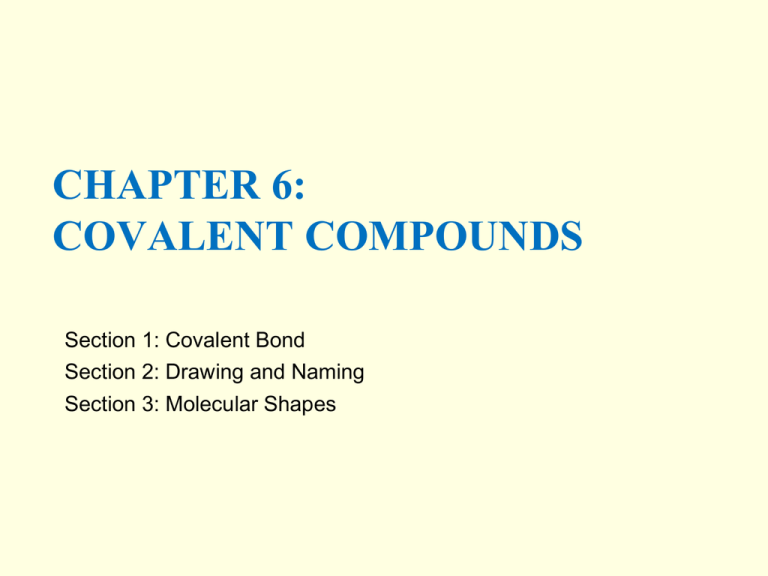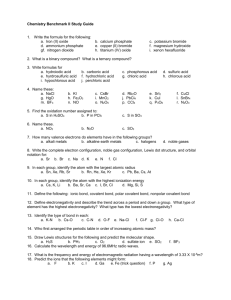NON-POLAR BONDING results when two identical non
advertisement

CHAPTER 6: COVALENT COMPOUNDS Section 1: Covalent Bond Section 2: Drawing and Naming Section 3: Molecular Shapes Chapter 6 Section 1 Covalent Bonds Objectives • Explain the role and location of electrons in a covalent bond. • Describe the change in energy and stability that takes place as a covalent bond forms. • Distinguish between nonpolar and polar covalent bonds based on electronegativity differences. • Compare the physical properties of substances that have different bond types, and relate bond types to electronegativity differences. Covalent bond = Sharing electrons A covalent bond is a bond formed when atoms share one or more pairs of electrons. non-metals and non-metals or hydrogen and nonmetals. and halogens They share electrons so that both of them can have a stable octet. Covalent bond animation Formation of a Covalent Bond A molecular orbital is the region of high probability that is occupied by an individual electron as it travels with a wavelike motion in the 3D space around one of two or more associated nuclei. Section 1 Covalent Bonds Energy and Stability Energy Is Released When Atoms Form a Covalent Bond Molecule is more stable = less energy PE=0 (like the ball at the bottom of the hill) Bond length: distance from one nucleus to the other that gives lowest PE (balance between repulsive force of nuclei, and being separate atoms) Bond information Bonds are flexible: vibrate and rotate Bond energy: they have different strengths. (shorter bond length = stronger bond) Bond strength: single<double<triple Electronegativity - The ability of an atom to attract electrons in another atom • The difference in electronegativity ( ) between two atoms in a bond to determine how the electrons are shared or not. Chapter 6 Predicting Bond Character from Electronegativity Differences There are two types of covalent bonding. In a bond atoms can share the electrons: 1. Sharing equally = Non-polar bonding 2. Sharing unequally = Polar bonding The number of shared electrons depends on the number of electrons needed to complete the octet. Ionic vs. Covalent Nonpolar covalent bond (pure covalent) - a weak covalent bond in which the bonding (valence) electrons are shared equally ( < 0.5) Polar covalent bond - a medium-strength covalent bond in which the bonding electrons are not shared equally ( generally between 0.5 and 2.1) Ionic bond - a strong bond created by the strong electrostatic attraction of + ions and - ions. Electrons have been given up by the cation and taken by the anion. ( generally greater than 2.1) Electronegativity difference = Calculate how electrons are shared using Electronegativity. 0 0.5 2.1 ionic 3.3 Practice: Order the following bonds according to increasing polarity: H--H, O--H, F--H, S--H, Cl--H Chapter 6 Section 1 Covalent Bonds 1. Greater electronegativity differences tend to cause stronger bonds. 2. Stronger bonds generally have shorter bond lengths. Chapter 6 Section 1 Covalent Bonds Polarity Is Related to Bond Strength • In general, the greater the electronegativity difference, the greater the polarity and the stronger the bond. NON-POLAR BONDING results when two identical nonmetals equally share electrons between them. POLAR BONDING results when two different non-metals unequally share electrons between them. Every PB has a Dipole. One end of the bond is more negative (higher EN) and the other end is positive (lower EN). (delta) is the sign for the more negative end for the more positive end Example: Hydrogen bonded to Oxygen EN=2.1 EN=3.5 Physical Properties and Polarity Covalent compounds (non-polar and polar), molecules with more polarity are more attracted to each other and thus have higher melting and boiling points. Solubility: like dissolves like Polar dissolves polar and ionic (water and salt, water and sugar) Non-polar dissolves non-polar (Oil dissolves fats) Oil and water don’t mix! Chapter 6 Properties of Substances with Metallic, Ionic, and Covalent Bonds Group activity group of two (discuss together and answer) Complete each statement below by choosing a term from the following list. Terms may be used more than once. Energy Polar covalent electronegativity nonpolar covalent dipole length 1. Bond ___________ is defined as the average distance between two bonded atoms at their minimum PE. 2. Bond ________ is defined as the energy required to break the chemical bond between two atoms and separate them. 3. A ________ bond is an attraction between two atoms in which bonding electrons are shared equally between the atoms. 4. A ________ bond is an attraction between two atoms in which bonding electrons are localized on the more EN atom. 5. A _________ molecule is one that has a partial positive charge at one end and partial negative charge at the opposite end.






